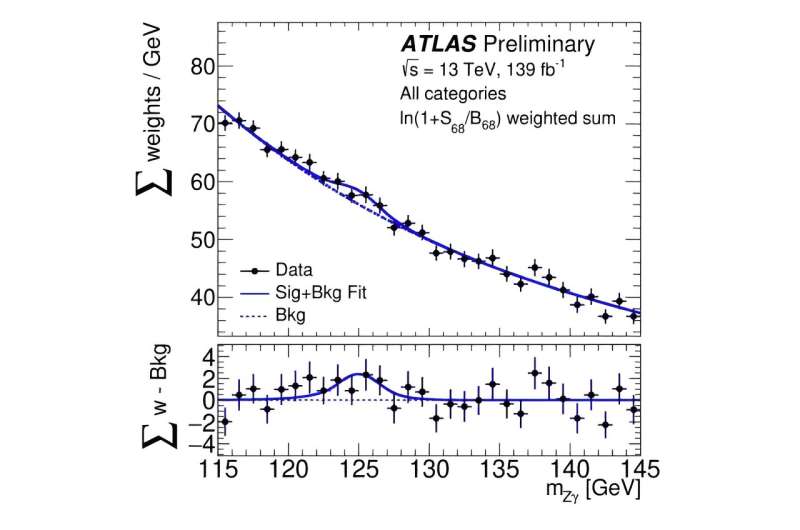January 25, 2024 feature
This article has been reviewed according to Science X's editorial process and policies. Editors have highlighted the following attributes while ensuring the content's credibility:
fact-checked
peer-reviewed publication
trusted source
proofread
Rare decay of the Higgs boson may point to physics beyond the Standard Model

Particle physicists have detected a novel decay of the Higgs boson for the first time, revealing a slight discrepancy in the predictions of the Standard Model and perhaps pointing to new physics beyond it. The findings are published in the journal Physical Review Letters.
The Higgs boson, predicted theoretically since the 1960s, was finally detected in 2012 at the CERN laboratory in Europe. As a quantum field it permeates all of space, through which other particles move, acquiring mass via their interaction with the Higgs field that can be roughly envisioned as a kind of resistance to their motion.
Many properties of the Higgs boson, including how it interacts with other particles and their associated fields, have already been measured to be consistent with predictions of the Standard Model.
But one Higgs decay mode that had yet to be investigated was a theoretical prediction that a Higgs boson would occasionally decay and produce a photon, the quantum of light, and a Z boson, which is an uncharged particle that together with the two W bosons conveys the weak force.
Scientists from the ATLAS and CMS collaborations at CERN used data from proton-proton collisions taken from Run 2 from 2015 to 2018 to search for this particular Z+photon Higgs decay. The Large Hadron Collider (LHC) at CERN is the high-energy particle accelerator near Geneva, Switzerland that circulates protons in opposite directions while causing them to collide at specific detector points, millions of times per second.
For this run the energy in the collision of the two protons was 13 trillion electron-volts, just below the machine's current maximum, which in more relatable units is 2.1 microjoules. That's about the kinetic energy of the average mosquito, or a grain of salt, traveling one meter per second.
Theory predicts that about 15 times per 10,000 decays, the Higgs boson should decay into a Z boson and a photon, the rarest decay in the Standard Model. It does so by first producing a pair of top quarks, or a pair of W bosons, which themselves then decay into the Z and photon.
The Atlas/CMS collaboration, work from more than 9,000 scientists, found a "branching ratio," or fraction of decays of 34 times per 10,000 decays, plus or minus 11 per 10,000—2.2 times the theoretical value.
The measured fraction is too large—3.4 standard deviations above the theoretical value, a number still too small to rule out a statistical fluke. Still, the relatively large difference hints at the possibility of a meaningful discrepancy from theory that could be due to physics beyond the Standard Model—new particles that are the intermediaries other than the top quark and W bosons.
One possibility for physics beyond the Standard Model is supersymmetry, the theory that posits a symmetry—a relationship—between particles of a half-spin, called fermions, and integer spin, called bosons, with every known particle having a partner with a spin differing by a half-integer.
Many theoretical physicists have long been advocates of supersymmetry as it would solve many conundrums that plague the Standard Model, such as the large difference (1024) between the strengths of the weak force and gravity, or why the mass of the Higgs boson, about 125 gigaelectron-volts (GeV), is so much less than the grand unification energy scale of about 1016 GeV.
In the experiment, the massive Z boson decays in about 3 × 10-25 seconds, long before it would reach a detector. So the experimenters compensated by looking at the energy of the two electrons or two muons the Z decay would produce, requiring their combined mass be larger than 50 GeV, a significant fraction of the Z's mass of 91 GeV.
"This very nice result obtained together with the CMS collaboration. It is, according to the Standard Model prediction, the rarest Higgs boson final state, for which we have seen first evidence," said Andreas Hoecker, spokesperson for the ATLAS collaboration.
"The decay occurs through quantum loops and is thus sensitive to new physics in a similar, but not quite the same way as the two-photon decay, which contributed to the Higgs boson discovery by ATLAS and CMS in 2012."
"This result is impressive for several reasons," added Monica Dunford of the ATLAS Physics collaboration. "We are experimentally able to measure with such precision these very rare processes. They are a powerful test of the Standard Model and possible theories beyond it."
Dunford adds that the groups have acquired new data during Run 3 at CERN, which began in July 2022, with 13.6 TeV of total energy. Even more data will come from the High Luminosity Large Hadron Collider, which will provide about five times more proton-proton collisions per second. The HL-LHC is projected to come online in 2028.
"These results are a preview of what we will continue to be able to achieve," said Dunford.
More information: G. Aad et al, Evidence for the Higgs Boson Decay to a Z Boson and a Photon at the LHC, Physical Review Letters (2024). DOI: 10.1103/PhysRevLett.132.021803
Journal information: Physical Review Letters
© 2024 Science X Network





















